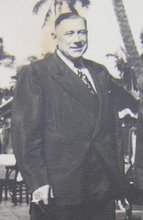
Sunday, January 14, 2007
Barron's Business Library

"It's In The Marketing"


Above Images: The British version (top) and French version of the Uncle Ben's websites (found HERE and HERE) provide a more accurate portrayal of the genesis of Uncle Ben's "converted" rice. To better view the images, click either to enlarge. Erich Huzenlaub was born in Germany and eventually became a British citizen. It was in England that he worked with his friend and fellow scientist, Francis Rogers. It was also here that he met Forrest Mars. As Huzenlaub had become a British citizen and Uncle Ben's is an American company, the above marketing pitch is attractive to build a bridge between British customers and the American company. You also will see how they tie in France as part of the genesis to endear themselves to French consumers. This is understandable and it makes sense.
Bottom Image: However, in the United States, the below story is told on the Uncle Ben's website. American audience, American story. No foreigners mentioned as to the true start of the company. While the first paragraph is accurate, the second is not entirely accurate. Compare the sites and see the difference. The company would be better suited to share a consistent message around the world as to the genesis of the great company that is Uncle Ben's. Click on the below image to enlarge or visit the site for yourself HERE.

Rice for G.I.'s - Time Magazine August 28, 1944

RICE FOR G.I.'s
Time Magazine Archives
Next week Texas' Gordon L. Harwell and Forrest E. Mars (Mars Candy) will start building a new $750,000 plant at Houston, Tex., to process vitaminized, weevil-proof rice for G.l.s in the hot-weather zones overseas. Financed by Defense Plant Corp. and given a high priority by the War Production Board, the new plant will process 25 to 30 million Ibs. of rice per year for the Army.
Harwell and Mars are U.S. licensees for a rice-milling process developed by German Biochemist Erich Gustav Huzenlaub (now a naturalized British citizen), which forces the vitamins and minerals firmly into the heart of the rice. For the past year and a half, Harwell, who snapped up the Huzenlaub Process after others turned it down, has been struggling to fill Army orders from his original pilot plant. Anxious to get more "converted rice," the Army got behind Mars's and Harwell's plan for a new plant. Last week Harwell hurried aboard an airliner at Washington, Houston-bound with his high-priority certificate and a bundle of blueprints. The plant is scheduled to be completed by January 1, 1945.
To the Quartermaster's Office, the Huzenlaub product is important for two reasons :
1. The hot-weather lands of the South Pacific abound with broad-snouted weevils. The weevils ruin ordinary rice before the men get it. But the Quartermaster's Office can put Huzenlaub's "converted rice" into any kind of bag, ship it to New Guinea or Saipan and never worry about weevils because the milling process makes each grain so slick and hard the weevil can't make a dent in it. It can be stored indefinitely.
2. Water-soluble vitamins and minerals, which are lost to rice when the brown bran husk is removed in the usual commercial milling process, are largely retained in the Huzenlaub Process.
"Converted rice" costs the Army 80¢ per 100-lb. bag more than ordinary commercial rice (average price—$7.72 per 100 Ibs.). Harwell was granted the higher ceiling for his special type several months ago, over the opposition of other millers. But with the greater capacity and efficiency of the new plant he hopes the price will soon be lowered. The Army thinks the premium a small one to pay to give the G.I. relief from dehydrated vegetables. - August 28, 1944
